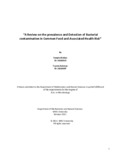| dc.description.abstract | Foodborne diseases are becoming a serious public health problem throughout the world, with 48
million illnesses and 3,000 fatalities projected in the United States each year. Over 1.7 billion cases
of diarrheal disease-related deaths in children are recorded worldwide each year, with the bulk of
these cases attributed to polluted food and water. Food-borne infections cause more medical care
and fatalities in children under the age of four than in any other age group. Foodborne illness is
caused by two different factors: food intoxication and food infection. Foodborne illness agents are
capable of not just decapitating large numbers of people, but also of causing severe mortality and
disability. There is increasing evidence that persons from minority racial and ethnic groups are
more likely to contract foodborne illnesses. The food and beverage industries constitute a key part
of the economy in many countries. Every day, they serve millions of people with a wide range of
ready-to-eat (RTE) meals and drinks sold and occasionally prepared in public spaces. Food sources
as diverse as meat, fish, natural goods, vegetables, grains, and cereals based on ready-to-eat food
variations, frozen produce, and refreshments are included in road-distributed food types. RTE
foods are ones that have not been further treated before being ingested in a way that considerably
lowers microbial load. According to the World Health Organization, contaminated foods are
responsible for up to 70% of diarrheal infections, and food-borne illnesses are the leading cause of
death, killing an estimated 2.1 million people globally, the majority of whom are children in
developing countries. Clostridium botulinum, E. coli, Salmonella spp., Listeria monocytogenes,
Yersinia enterocolitica, Staphylococcus aureus, Shigella spp., Bacillus cereus, and Campylobacter
jejuni are the most prevalent foodborne pathogens in the bacterial domain. Escherichia coli,
Shigella sp., Staphylococcus sp., Bacillus spp., Klebsiella spp., Listeria monocytogenes, and other
foodborne pathogens have all been documented. This review will highlight the Prevalence and | en_US |

